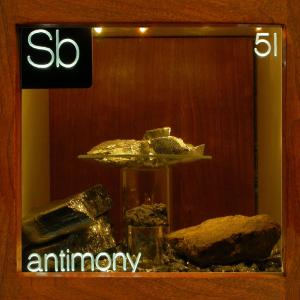Home Size: 1 2 3 4 5 6 7 8 9
|
 |
| A hard, brittle, shiny, crystalline semi-metal which also exists as a grey powder. It is stable in dry air and quite toxic.
|
|
|
 |
Broken ingot.
Antimony shares with bismuth, gallium and water the unusual property of expanding slightly when it freezes. This makes it ideal for casting, where it pushes its way tightly into the mold to reproduce fine detail. As a result, antimony is included in the alloys used to make typefaces for printing presses: 60% lead, 30% antimony and 10% tin is a traditional recipe.
Source: Home made
Size: 3"
Purity: 99.9%
|
|
 |
Large crystals.
These are particularly lovely chunks of antimony. When it freezes, antimony sometimes produces a beautiful fern-like pattern on its surface. Fragments of this pattern are just visible on some of these pieces.
Source: eBay
Size: 1"
Purity: 99.9%
|
|
 |
Bulk commercial granules.
There is only a limited amount one can say about several different samples of the pure element. So to keep you amused, here is a surprising fact culled from John Emsley's commendable book about the elements called "Nature's Building Blocks". Apparently antimony's laxative properties were well know in the Middle Ages when reusable pills of the solid element were sold. After having the desired effect, the expelled pills could be retrieved from and (after washing one hopes) kept handy for a future bout of constipation.
Source: Shooting supplier
Size: 0.5"
Purity: 99%
|
|
 |
Native antimony.
Native antimony is very rarely found in the form of crystals, usually occurring in ore veins, massive or nodules. These nodules make particularly attractive specimens - the outsides are covered with a thin, dull rind of antimony oxide minerals but when broken open reveal sparkling silvery surfaces of fresh antimony. Antimony forms in hydrothermal veins, particularly in association with arsenic, silver and other minerals.
Source: Mackay mineral collection
Size: 2"
Purity: >95%
|
|

